高中英语必修一人教版:Unit+2+语法+教学设计-
- 格式:doc
- 大小:31.00 KB
- 文档页数:2
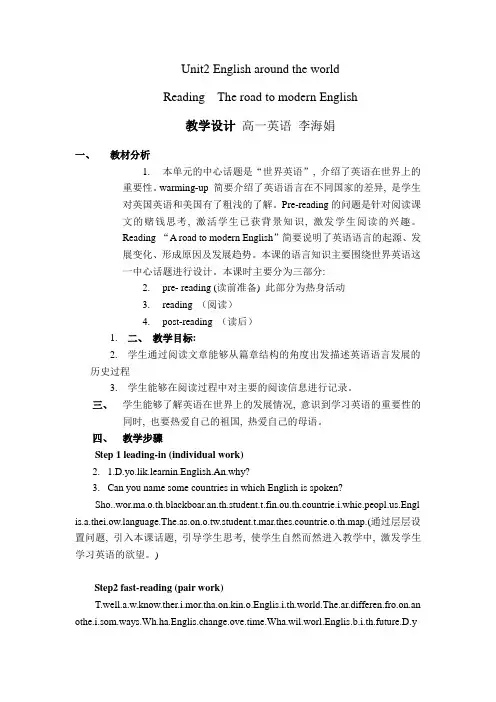
Unit2 English around the worldReading The road to modern English教学设计高一英语李海娟一、教材分析1.本单元的中心话题是“世界英语”, 介绍了英语在世界上的重要性。
warming-up 简要介绍了英语语言在不同国家的差异, 是学生对英国英语和美国有了粗浅的了解。
Pre-reading的问题是针对阅读课文的赌钱思考, 激活学生已获背景知识, 激发学生阅读的兴趣。
Reading “A road to modern English”简要说明了英语语言的起源、发展变化、形成原因及发展趋势。
本课的语言知识主要围绕世界英语这一中心话题进行设计。
本课时主要分为三部分:2.pre- reading (读前准备) 此部分为热身活动3.reading (阅读)4.post-reading (读后)1.二、教学目标:2.学生通过阅读文章能够从篇章结构的角度出发描述英语语言发展的历史过程3.学生能够在阅读过程中对主要的阅读信息进行记录。
三、学生能够了解英语在世界上的发展情况, 意识到学习英语的重要性的同时, 也要热爱自己的祖国, 热爱自己的母语。
四、教学步骤Step 1 leading-in (individual work)2. 1.D.yo.lik.learnin.English.An.why?3.Can you name some countries in which English is spoken?.Engl nguage.The.as.on.o.tw.student.t.mar.thes.countrie.o.th.map.(通过层层设置问题, 引入本课话题, 引导学生思考, 使学生自然而然进入教学中, 激发学生学习英语的欲望。
)Step2 fast-reading (pair work)T.well.a.w.know.ther.i.mor.tha.on.kin.o.Englis.i.th.world.The.ar.differen.fro.on.an othe.i.som.ways.Wh.ha.Englis.change.ove.time.Wha.wil.worl.Englis.b.i.th.future.D.yChec.th.answers.As.som.student.t.tel.thei.answers.afte.givin.th.answers.the.shoul .als.tel.ho.the.fin.th.answers.(快速阅读后要求学生了解文章大意, 并能对全文的结构有一个认识。
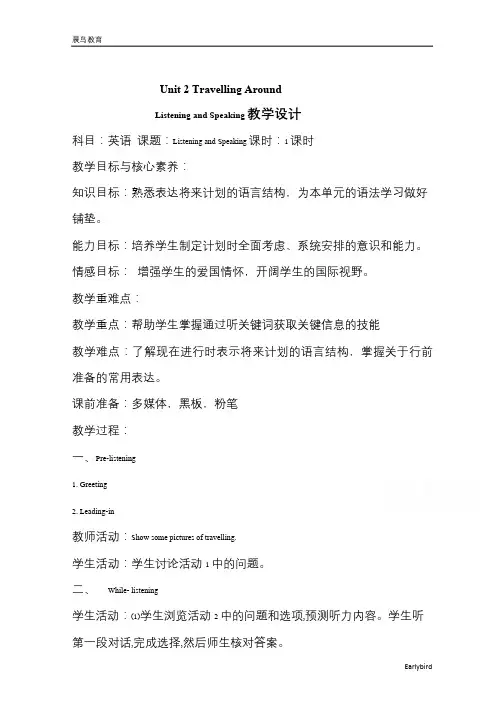
Unit 2 Travelling AroundListening and Speaking 教学设计科目:英语课题:Listening and Speaking 课时:1 课时教学目标与核心素养:知识目标:熟悉表达将来计划的语言结构,为本单元的语法学习做好铺垫。
能力目标:培养学生制定计划时全面考虑、系统安排的意识和能力。
情感目标:增强学生的爱国情怀,开阔学生的国际视野。
教学重难点:教学重点:帮助学生掌握通过听关键词获取关键信息的技能教学难点:了解现在进行时表示将来计划的语言结构,掌握关于行前准备的常用表达。
课前准备:多媒体,黑板,粉笔教学过程:一、Pre-listening1. Greeting2. Leading-in教师活动:Show some pictures of travelling.学生活动:学生讨论活动1 中的问题。
二、While- listening学生活动:(1)学生浏览活动2 中的问题和选项,预测听力内容。
学生听第一段对话,完成选择,然后师生核对答案。
(2)学生浏览活动3 的听力任务,明确需要回答的问题,学生听第二段对话,记录问题答案,然后互相核对答案。
然后师生核对答案。
(3)学生根据短语搭配先尝试在活动4 的表格空白处填人适当的词语,然后听录言核对答案。
教师活动:Show the listening text and pay attention to the structure of “bedoing”三、After-listening学生活动:运用学到的短语创编对话,以“ How are you getting readyfor your trip”为主题。
并在班内展示。
四、Summary总结课上所学。
作业布置:复习课上所学生词和短语。
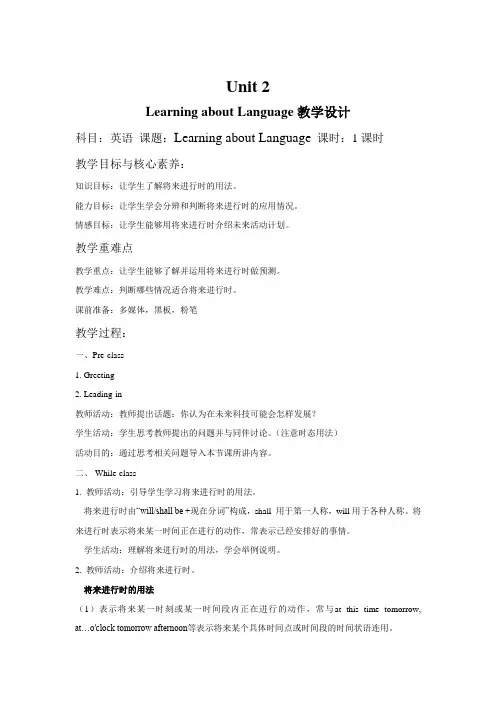
Unit 2Learning about Language教学设计科目:英语课题:Learning about Language课时:1课时教学目标与核心素养:知识目标:让学生了解将来进行时的用法。
能力目标:让学生学会分辨和判断将来进行时的应用情况。
情感目标:让学生能够用将来进行时介绍未来活动计划。
教学重难点教学重点:让学生能够了解并运用将来进行时做预测。
教学难点:判断哪些情况适合将来进行时。
课前准备:多媒体,黑板,粉笔教学过程:一、Pre-class1. Greeting2. Leading-in教师活动:教师提出话题:你认为在未来科技可能会怎样发展?学生活动:学生思考教师提出的问题并与同伴讨论。
(注意时态用法)活动目的:通过思考相关问题导入本节课所讲内容。
二、While-class1. 教师活动:引导学生学习将来进行时的用法。
将来进行时由“will/shall be +现在分词”构成,shall 用于第一人称,will用于各种人称。
将来进行时表示将来某一时间正在进行的动作,常表示已经安排好的事情。
学生活动:理解将来进行时的用法,学会举例说明。
2. 教师活动:介绍将来进行时。
将来进行时的用法(1)表示将来某一时刻或某一时间段内正在进行的动作,常与at this time tomorrow, at…o'clock tomorrow afternoon等表示将来某个具体时间点或时间段的时间状语连用。
(2)将来进行时可以表示已经计划好的事(3)将来进行时用来表示委婉客气(4)将来进行时可以表示现在正在进行的动作,但这个动作会延续到将来。
(5)将来进行时可以用于解释原因。
【注意】一般将来时强调的是“将来要发生”的动作和状态,而将来进行时表示“将来某个时间正在进行”的动作。
学生活动:学生学习其他将来时的表达方法,并进行造句练习。
一般将来时与将来进行时的区别(1)一般将来时表示事先没有考虑而只是在说话时作出的决定;也用于表示事物的倾向性或规律性。
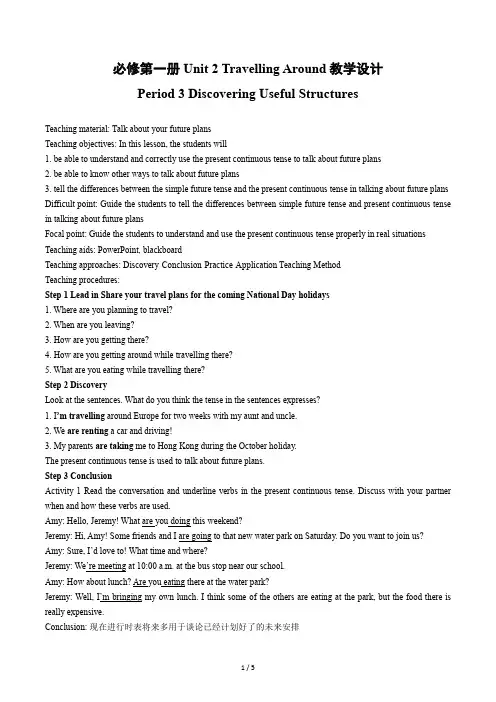
必修第一册 Unit 2 Travelling Around教学设计Period 3 Discovering Useful StructuresTeaching material: Talk about your future plansTeaching objectives: In this lesson, the students will1. be able to understand and correctly use the present continuous tense to talk about future plans2. be able to know other ways to talk about future plans3. tell the differences between the simple future tense and the present continuous tense in talking about future plans Difficult point: Guide the students to tell the differences between simple future tense and present continuous tense in talking about future plansFocal point: Guide the students to understand and use the present continuous tense properly in real situations Teaching aids: PowerPoint, blackboardTeaching approaches: Discovery-Conclusion-Practice-Application Teaching MethodTeaching procedures:Step 1 Lead in Share your travel plans for the coming National Day holidays1. Where are you planning to travel?2. When are you leaving?3. How are you getting there?4. How are you getting around while travelling there?5. What are you eating while travelling there?Step 2 DiscoveryLook at the sentences. What do you think the tense in the sentences expresses?1. I’m travelling around Europe for two weeks with my aunt and uncle.2. We are renting a car and driving!3. My parents are taking me to Hong Kong during the October holiday.The present continuous tense is used to talk about future plans.Step 3 ConclusionActivity 1 Read the conversation and underline verbs in the present continuous tense. Discuss with your partner when and how these verbs are used.Amy: Hello, Jeremy! What are you doing this weekend?Jeremy: Hi, Amy! Some friends and I are going to that new water park on Saturday. Do you want to join us? Amy: Sure, I’d love to! What time and where?Jeremy: We’re meeting at 10:00 a.m. at the bus stop near our school.Amy: How about lunch? Are you eating there at the water park?Jeremy: Well, I’m bringing my own lunch. I think some of the others are eating at the park, but the food there is really expensive.Conclusion: 现在进行时表将来多用于谈论已经计划好了的未来安排1. 用于大多数表示位置移动的动词(位移动词)(短语):go, come, travel, leave, bring, take, arrive, return, start, fly, visit, take off, land, see off, set off等2. 也可用于非位移动词(短语):eat, do, meet, plan, buy, have, spend, play, finish, stay, rent, book, attend, pack, contact, apply for, pick up, check out等,此时常常与表示将来的时间状语连用。
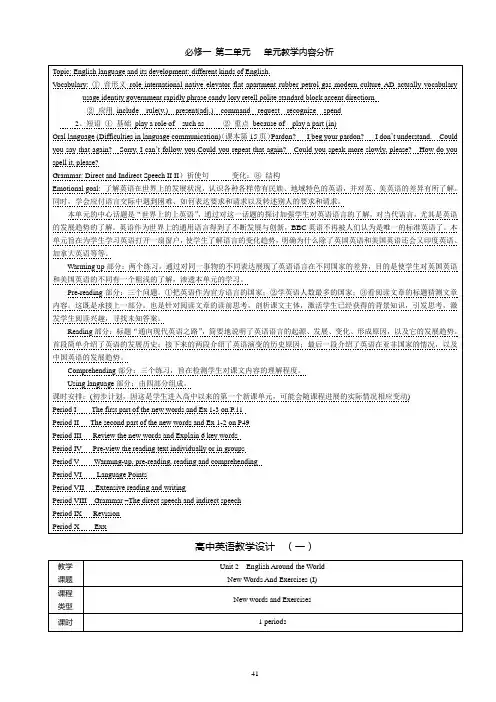
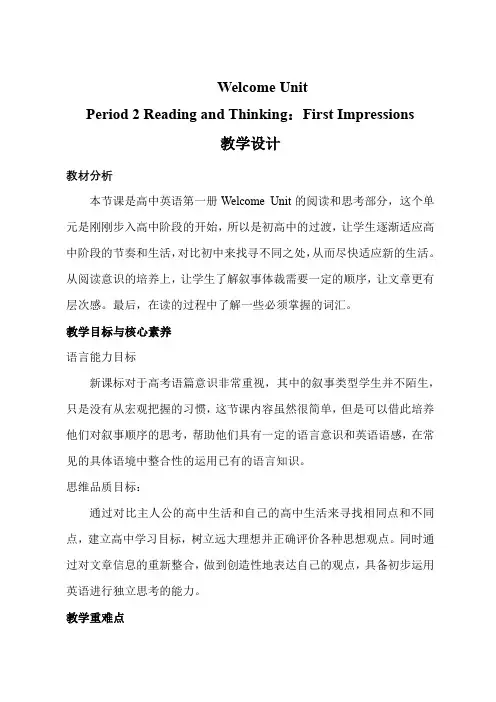
Welcome Unit
Period 2 Reading and Thinking:First Impressions
教学设计
教材分析
本节课是高中英语第一册Welcome Unit的阅读和思考部分,这个单元是刚刚步入高中阶段的开始,所以是初高中的过渡,让学生逐渐适应高中阶段的节奏和生活,对比初中来找寻不同之处,从而尽快适应新的生活。
从阅读意识的培养上,让学生了解叙事体裁需要一定的顺序,让文章更有层次感。
最后,在读的过程中了解一些必须掌握的词汇。
教学目标与核心素养
语言能力目标
新课标对于高考语篇意识非常重视,其中的叙事类型学生并不陌生,只是没有从宏观把握的习惯,这节课内容虽然很简单,但是可以借此培养他们对叙事顺序的思考,帮助他们具有一定的语言意识和英语语感,在常见的具体语境中整合性的运用已有的语言知识。
思维品质目标:
通过对比主人公的高中生活和自己的高中生活来寻找相同点和不同点,建立高中学习目标,树立远大理想并正确评价各种思想观点。
同时通过对文章信息的重新整合,做到创造性地表达自己的观点,具备初步运用英语进行独立思考的能力。
教学重难点
1.重点
(1)通过skimming 的方式快速找出文章的叙述顺序;
(2)学会用已知的内容去解决未知的问题,用已经了解的词汇去学习新的词汇;
2. 难点
(1)可以分辨叙述顺序,并可以换一种顺序来叙述;
(2)学会寻找一段中的关键词来重复故事。
教学过程。
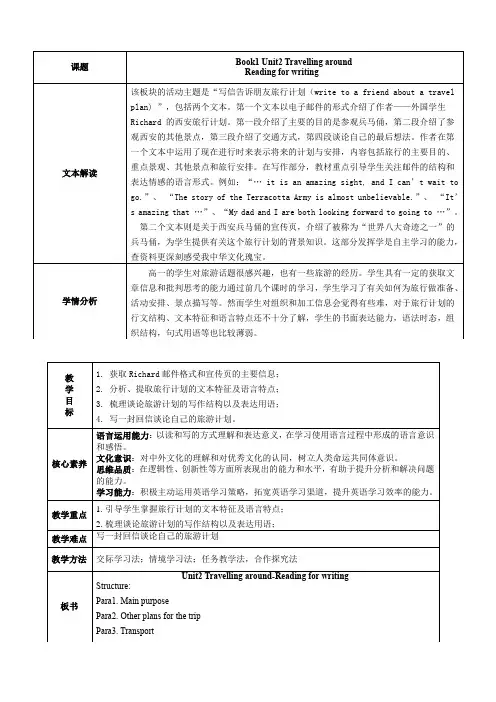
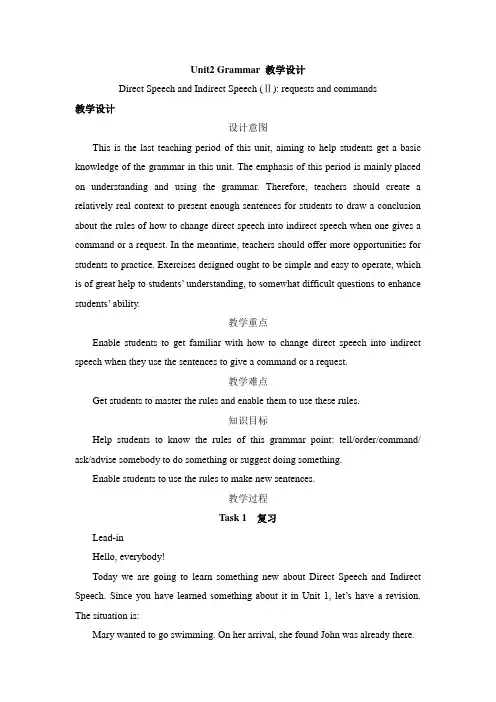
Unit2 Grammar 教学设计Direct Speech and Indirect Speech (Ⅱ): requests and commands教学设计设计意图This is the last teaching period of this unit, aiming to help students get a basic knowledge of the grammar in this unit. The emphasis of this period is mainly placed on understanding and using the grammar. Therefore, teachers should create a relatively real context to present enough sentences for students to draw a conclusion about the rules of how to change direct speech into indirect speech when one gives a command or a request. In the meantime, teachers should offer more opportunities for students to practice. Exercises designed ought to be simple and easy to operate, which is of great help to students’ understanding, to somewhat difficult questions to enhance stude nts’ ability.教学重点Enable students to get familiar with how to change direct speech into indirect speech when they use the sentences to give a command or a request.教学难点Get students to master the rules and enable them to use these rules.知识目标Help students to know the rules of this grammar point: tell/order/command/ ask/advise somebody to do something or suggest doing something.Enable students to use the rules to make new sentences.教学过程Task 1 复习Lead-inHello, everybody!Today we are going to learn something new about Direct Speech and Indirect Speech. Since you have learned something about it in Unit 1, let’s have a revision. The situation is:Mary wanted to go swimming. On her arrival, she found John was already there.Look at the screen about four sentences that Mary said and change them into indirect speech. When you do the exercises, pay special attention to the rules.I. Change the sentences from direct speech into indirect speech.1. She said, “I want to go swimming now.”2. She said, “John, when did you set off for the swimming pool?”3. She said to John, “Do you come here by bike or by bus?”4. She said, “Practice makes perfect.”The teacher gives students several minutes to finish the exercises. Students give the answers and they also need to point out the rules. The teacher writes down the key words of the rules on the blackboard.When students give their answers, make sure that they:①have a good command of the rules about the change of persons, tenses, pronouns and adverbials.②know the differences about the transformation between declarative sentences and interrogative sentences.Ⅱ. Fill in the blanks.1. A. She said, “My brother left home three years ago.”B. She said brother home three years .2. A: He asked me, “Will you go to the park this evening?”B: He asked me I to the park evening.3. A: She said, “What are you doing?”B: She asked me doing.Ⅲ. Multiple choices.1. I asked them they got married.A. whoB. thatC. whichD. when2. ——What did she think of the film?。
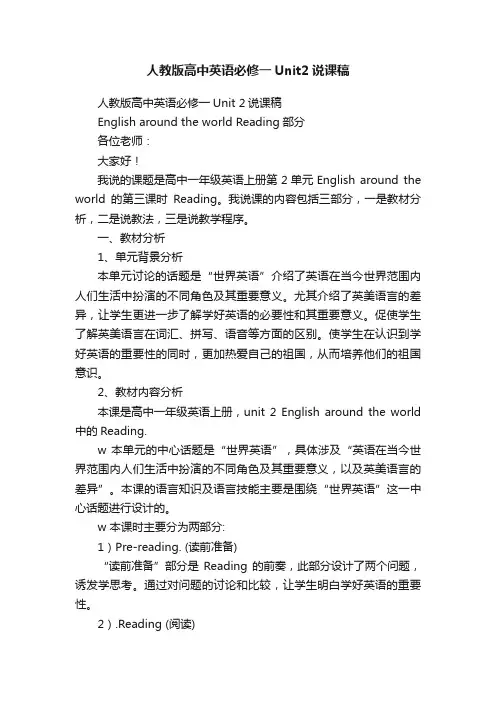
人教版高中英语必修一Unit2说课稿人教版高中英语必修一Unit 2说课稿English around the world Reading部分各位老师:大家好!我说的课题是高中一年级英语上册第2单元English around the world的第三课时Reading。
我说课的内容包括三部分,一是教材分析,二是说教法,三是说教学程序。
一、教材分析1、单元背景分析本单元讨论的话题是“世界英语”介绍了英语在当今世界范围内人们生活中扮演的不同角色及其重要意义。
尤其介绍了英美语言的差异,让学生更进一步了解学好英语的必要性和其重要意义。
促使学生了解英美语言在词汇、拼写、语音等方面的区别。
使学生在认识到学好英语的重要性的同时,更加热爱自己的祖国,从而培养他们的祖国意识。
2、教材内容分析本课是高中一年级英语上册,unit 2 English around the world 中的Reading.w 本单元的中心话题是“世界英语”,具体涉及“英语在当今世界范围内人们生活中扮演的不同角色及其重要意义,以及英美语言的差异”。
本课的语言知识及语言技能主要是围绕“世界英语”这一中心话题进行设计的。
w 本课时主要分为两部分:1)Pre-reading. (读前准备)“读前准备”部分是Reading的前奏,此部分设计了两个问题,诱发学思考。
通过对问题的讨论和比较,让学生明白学好英语的重要性。
2).Reading (阅读)“阅读”部分文体为说明文,全文共分三个段落。
全文阐述了一个鲜明的观点:英语的确是当今世界范围内使用最广泛的一门语言之一,也是联合国的工作语言之一,它的重要作用是其他语言不可替代的。
3)Post-reading(读后)“读后”部分共设计了两类题型:第一部分是和个问题,其中前面两个是细节理解题;第三题是一个开放性题目,鼓励学生把英语学习与现实生活相结合。
第二部分是填空形式,帮助学生梳理文章,掌握文章主要细节,概括中心思想,实为文章的一个纲要。
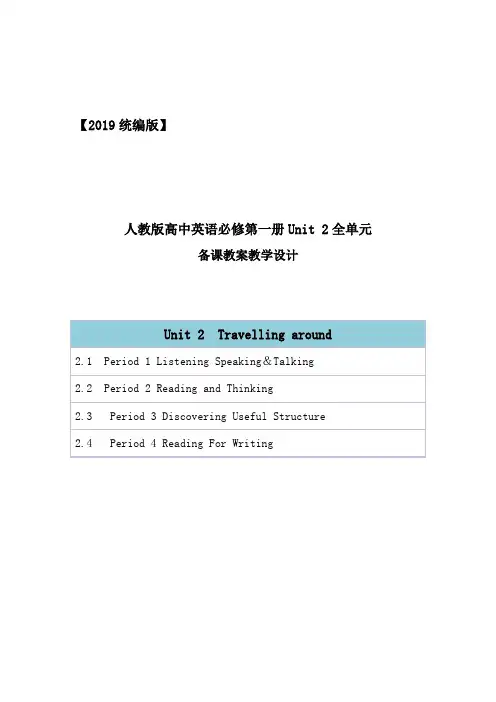
【2019统编版】人教版高中英语必修第一册Unit 2全单元备课教案教学设计Period 1 Listening Speaking&Talking教学目标与核心素养:1. Instruct students to get main facts by listening and motivate them to talk about the topics about how to prepare for the trip and make reservations by listening and ultimately can make travel arrangements and reservations.2. Develop students’ sense of cooperativ e learning and individual thinking capability.3. Develop students’ different listening skills to solve different listening comprehensive problems.4. Help students to understand how to use the structures “the present continuous tense (be doing) is used to express future plans.教学重难点:1. Teach students how to focus on key words, not on single words or grammar.2. Prompt Ss to talk about the related topics, such as how to prepare for the trip and make a travel plan.教学过程:Part 1: Listening and SpeakingLead inThe teacher is advised to talk with their students about the places that they want to travel most both at home and abroad: boys and girls, if you have a chance to travel around the world, where will you go? After their small talk, the teacher can move on by finishing the following listening task:Before travelling, what do we need to prepare for the trip?After finishing the task above, the teacher is expected to play conversation 1 which is about Paul and Meilin’s conversation about coming holiday and after finishing listening for the first time, the studentsneed to solve the following task.1.Circle the two places Meilin is going to for holiday.A. Germany. B. England. C. Iceland. D. France.2. How is she going to get there?A. By sea.B. By air. C .By train.3 How is she planning to get around after she arrives?A .By car. B. By train. C. On foot.Listening tip:After finishing the task above, the teacher is expected to play conversation 2 which is about where and why Paul is visiting with his family and after finishing listening, the students need to solve the following task.Listen to Conversation 2. Then answer the following questions:1.Where is Paul's family going over the holiday?2. Why are they going there?After finishing the task above, the teacher is expected to play conversation 3 which contains the whole conversation and solve the following task.Fill in the table below:Finally, after finishing the task above, the teacher is expected to instruct students to work in groups to finish the following project: Speaking ProjectWork In pairs. Choose a travel destination and discuss how to prepare for the tripPart 2: Listening and Talking:The teacher is advised to talk with their new students about the related topic: Boys and girls, do you know how to make reservations for a trip? Let’s listen and find out:Play the listening and answer the following questions:1.What are the two speakers talking about?2.What is the relationship between the two speakers?2 Listen again and complete the table with the words you hear.Making reservationsOpening:Talking about timeTalking about what you prefer:Other informationPaymentTalking projectWork in groups.Imagine you are making plans for the holiday. Choose one of the situations below and role-play a phone call with a partner.Booking air tickets Booking a hotel room Booking a table for dinnerPeriod 2 Reading and Thinking教学目标与核心素养:1. Enable students to acquire the basic usage of the new words and expressions concerning the topic of traveling and learn to use them flexibly.2. Enable students to sum up some details related to Peru.3. Develop students’ sense of cooperative learning and individual thinking capability.4. Develop students’ different learning skills to solve different reading comprehensive problems, such as skimming, scanning and inferring.教学重难点:1. Develop students’ reading ability such as skimming, scanning and summarizing.2. Let students talk about their travel plans and topics about travelling.教学过程:1. Before readingStep 1 warming upHave a free talk with students. Ask them the following question:How much do you know about Peru? Let’s have a quiz. Show the quiz on the screen.Step2 Pre-readingPrediction:1. What types of text is the passage?2. Let students guess what the text will be mainly about before reading by looking at the picture and the title.Step3: Reading1. Fast readingAsk students to skim the reading passage to find out some main details about Peru as quickly as possible by doing the multiple choice test.1. Peru lies on the _________ coast of South America.A. PacificB. AtlanticC. ArcticD. India2. How many years did Spain control Peru about?_________A.1400.B.1500.C.300.D.100.3. How will you get the center of forest if you visit Amazon Rainforest?A. By air.B. By seaC. On foot.D. By car.4. If you want to enjoy stone buildings, which tour should you take?A. Amazon Rainforest TourB. Machu Picchu TourC. Cusco Tour D Lake Titicaca Tour5. Where is your accommodation while visiting Lake Titicaca?A. Local hotel.B. Visitor center.C. Stone building.D. Local home.2. Intensive readingAllow students to read the passage more carefully this time to sum up the features of each scenic spot.Step 4: Further Reading and discussionRead the text the third time and work in pairs to do the following task.Suppose you are a travel agent, and the following people want a package trip to Peru and ask for your advice. Please recommend them the destination according to their interest.Good expressions that students can choose to use: help the travelers choose which tour to take1. Mike, a well -paid photographer, who has great interest in adventuring and exploration. He hopes to have an active holiday and shoot some pictures of different kinds of animals. He doesn’t need first class accommodation.2. Bill is a reporter, who not only enjoys learning about the culture and lifestyle of the country, but also likes admiring beautiful scenery. He needs to make a report about the local people’s life of this country.3. Tom, a hiking lover, hopes to spend some days hiking while enjoying the beautiful natural scenery.4. Mary, a designer, is planning to make a trip to a place, where she can enjoy the different architecture of this country and some excellent food. She also likes going shopping.1.In my opinion, you could/might choose…, because you prefer to…2.Could be a perfect choice for you, for…3.As far as I am concerned, you would enjoy…, for…4.Would probably suit you, because you enjoys/ love/hate doing…Step 5: Passage ConsolidationLanguage appreciation:• 1. You can then spend three days exploring the rainforest with a local guide and enjoying the plants and animals unique to the rainforest.•[句式分析] 本句主体结构为spend some time doing sth.•exploring the rainforest 与_____________________为并列结构;____________作方式状语; unique to the rainforest为形容词短语作定语修饰____________•[尝试翻译]在接下来的三天里,您可以在当地导游的陪同下,深人雨林进行探索,欣赏雨林特有的动植物。
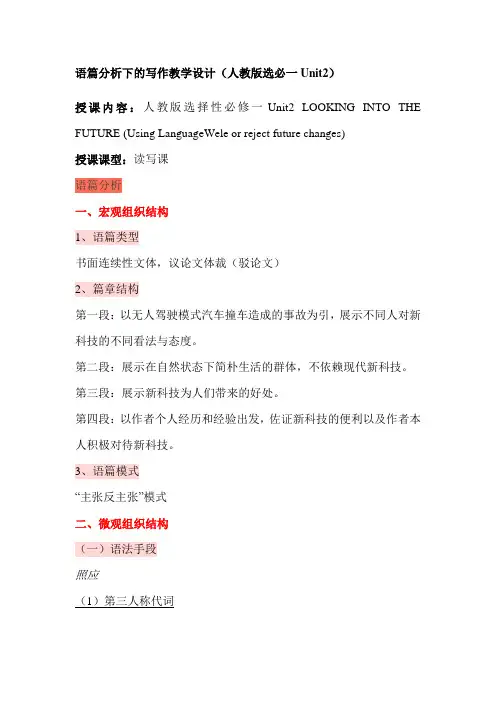
语篇分析下的写作教学设计(人教版选必一Unit2)授课内容:人教版选择性必修一 Unit2 LOOKING INTO THE FUTURE (Using LanguageWele or reject future changes)授课课型:读写课语篇分析一、宏观组织结构1、语篇类型书面连续性文体,议论文体裁(驳论文)2、篇章结构第一段:以无人驾驶模式汽车撞车造成的事故为引,展示不同人对新科技的不同看法与态度。
第二段:展示在自然状态下简朴生活的群体,不依赖现代新科技。
第三段:展示新科技为人们带来的好处。
第四段:以作者个人经历和经验出发,佐证新科技的便利以及作者本人积极对待新科技。
3、语篇模式“主张反主张”模式二、微观组织结构(一)语法手段照应(1)第三人称代词A: “They”集中体现在文本第二段:They do not...; They have lived... and they will...等B: “It”集中体现在文本第三段和第四段:Moreover, the Internet has made it possible...; It has also made..., as it allows...等(2)比较词语better than; rather than; much easier等(二)词汇手段1、词的重复:new technology; driverless car; accept; change; advance; benefit;work2、同义词:ceaseresist; advocateaccept;3、反义词:opposeaccept; the natural environmentpolluted cities4、上下义词:the Internetnetworks\social media(三)连接手段连词、副词、词组and; that; since; as; when; nevertheless; hence; personally; of course; but; on the one hand... on the other hand...等三、主题内容不同的人对待新科技的不同态度四、主题意义深入思考新技术对个人、生活、社会的影响,新技术可能带来的问题和如何解决,多角度思考科技与人、与社会的关系。
2024年人教版高一英语必修一unit2教案一、教学目标知识与技能学生能够掌握本单元的基本词汇和表达,包括描述人物特征、爱好、日常活动等。
学生能够熟练运用本单元的重点句型,进行简单的自我介绍和询问他人信息。
学生能够理解并运用本单元的阅读材料,获取文章中的关键信息。
过程与方法培养学生通过合作学习,共同解决问题的能力。
鼓励学生通过小组讨论、角色扮演等方式,积极参与课堂活动,提高英语应用能力。
引导学生在完成课堂任务的过程中,学会自主学习和探究学习。
情感、态度和价值观激发学生学习英语的兴趣和热情,增强他们的自信心。
帮助学生树立积极向上的学习态度,鼓励他们勇敢面对挑战。
培养学生的跨文化意识,使他们能够尊重并理解不同文化背景的人。
二、教学重点和难点教学重点本单元的重点词汇和表达,如描述人物特征的形容词、谈论日常活动的动词短语等。
本单元的重点句型,如使用“be good at”谈论某人的特长,使用“spend time doing sth.”描述日常活动等。
阅读材料的理解和应用,包括从文章中提取关键信息、理解作者的意图等。
教学难点对于某些生僻词汇的理解和记忆。
对于某些复杂句型的掌握和运用。
在阅读材料中,对于深层含义和文化背景的理解。
三、教学过程导入新课通过展示一些图片或视频,引导学生讨论图片中的人物特征、活动等,激发他们的兴趣和好奇心。
提出一些与本单元主题相关的问题,让学生思考并回答,为后续的学习做好铺垫。
词汇和句型学习教师呈现本单元的生词和短语,并解释其意义和用法。
通过例句和练习,让学生熟悉并掌握本单元的重点句型。
鼓励学生运用新学的词汇和句型进行自我介绍或描述他人,以检验他们的掌握情况。
阅读理解教师引导学生阅读本单元的阅读材料,并帮助他们理解文章的大意和细节。
通过提问和讨论的方式,让学生分析文章的结构、作者的意图以及文章中的深层含义。
鼓励学生将阅读材料与自己的生活经历联系起来,进行拓展思考和表达。
语法讲解与练习教师对本单元的语法知识进行系统讲解,包括时态、语态、非谓语动词等。
高中英语必修一unit2教案教学设计(一)高中英语必修一 Unit 2 教学设计教学目标•掌握本单元重点词汇和短语的读音、拼写和用法。
•熟练运用本单元的语法知识,能够正确运用一般现在时和一般过去时进行句子构建。
•能够理解并正确运用本单元的重点语言知识和交际用语。
教学重点•重点词汇和短语的掌握和运用。
•一般现在时和一般过去时的句子构建。
•口语和书面表达的实际应用。
教学准备•教科书:必修一 Unit 2•多媒体设备•单词卡片和图片教学过程Step 1:导入新课1.引入新课前,请学生预习相关内容,了解本单元的主题和基本内容。
2.利用多媒体设备播放与主题相关的图片或视频,激发学生的兴趣。
Step 2:语言输入1.根据教材内容,进行重点词汇和短语的讲解,并请学生跟读。
–重点词汇:(列举词汇列表)–重点短语:(列举短语列表)2.通过示范句子,引导学生学习使用一般现在时和一般过去时的句子构建。
–一般现在时:(示例句子)–一般过去时:(示例句子)3.练习语言输入,让学生进行口头对话练习,以巩固新学的词汇和句型。
Step 3:语言输出1.分组活动,让学生根据教材中的对话内容进行角色扮演,模拟真实情境,练习运用所学语言知识。
2.激发学生的创造力,让他们用一般现在时或一般过去时构建有关自己生活经历的句子。
3.学生之间进行交流,分享自己的句子,并互相给予反馈和建议。
Step 4:巩固练习1.在教室内,贴出单词卡片或图片,让学生进行词汇和短语的默写练习。
2.通过听力练习和阅读理解练习,检测学生对本单元语言知识的掌握情况。
3.布置相关练习作为课后作业,以查漏补缺。
Step 5:总结和归纳1.回顾本节课学习的重点和难点内容,做一个简单总结。
2.与学生一起梳理本单元的重点知识和技能,强化学习效果。
教学延伸•鼓励学生多阅读与本单元主题相关的文章或故事,拓宽他们的语言和文化视野。
•提供更多的口语练习机会,如角色扮演、小组讨论、辩论等。
人教高中英语必修一unit2教案Module 1 Unit 2 English around the world●单元规划本单元主要围绕English around the world这一主题介绍了英语的使用情况、发展情况及各地不同的方言。
第二单元English around the world的设计可分为五部分。
第一部分learn something about words and expressions;第二部分warming up and reading;第三部分the structure which expresses commands and requests;第四部分using language;第五部分writing and speaking;●课时安排本单元教学可分为6个课时。
第一课时vocabulary;第二课时为reading;第三课时为language points;第四课时为grammar;第五课时为using language;第六课时为writing and speaking;第七课时为revisionThe First Period Words and expressionsTeaching aims :1. Know the key words and expressions in the whole unit:elevator, petrol, official, voyage, actually, base, identity, command, request, recognize, straight, because of, come up, at present, such as, play a part (in)……2. Enable the students to get familiar with the pronunciation of the important words.3. Prepare for the learning process of the whole unit.Teaching important points :1.Get familiar with the words in the text part.2.Master the important expressions such as:bec ause of, come up, at present, such as, play a part (in)……Teaching methods: Task-based teaching and learning; cooperative-learning; group discussionTeaching procedures :Step 1、Self-directed learning学习方法指导:第一步:写出所给单词的音标;第二步:大声朗读三遍,注意画线字母的发音;第三步:依次写出画线字母的音标。
人教版高中英语必修一Unit 2 reading教学设计弦第一.教材本节课教材选取的是必修一第二单元阅读部分。
第二.教学目标1.语言目标●通过对单词的预习及听录音,能够熟读文章中出现的新单词。
●能够在讨论活动中用简单的英语发表自己的看法。
●掌握阅读基本技巧并予以运用。
2.情感目标●让学生认识到英语的重要性,激发学习热情。
●通过对英语发展过程的了解,培养他们的跨文化意识和世界意识。
●通过小组讨论培养团队合作意识。
第三.教学重点及难点●提高学生的阅读技巧——scanning 和 skimming。
由于学生刚从初中进入高中,对高中英语的阅读难度很难适应,因此迫切需要提高阅读技能。
这既是本节课的重点又是难点。
●能读懂文章,了解文章的基本大意及各段落大意。
学会快速找到每段的中心句。
●学会划出阅读理解题的关键词,并能在寻读过程中找到相关信息。
第四,教学过程Step1. Lead-in (6 minutes)课前放首英文歌(when you believe),为接下来的讨论提供信息。
问候完后问一个与学生实际相关的问题:How long have you learned English? 然后引出讨论话题:Why do so many people learn English? 两人一组进行讨论,用短语尽可能多的说出原因。
可在黑板上举个例子:To listen to the English songs,同时写出课前歌曲名字。
两分钟讨论后,让学生给出答案,幻灯片如下展示:然后再问学生:How much do you know about the English language? 再进入本课主题:the road to modern English.Step 2: Pre-reading (3 minutes)用三幻灯片预习本文中的生单词及短语,为阅读扫清障碍。
(对于许多没有做预习的学生来说,这一步是非常有必要的。
Unit2 Language points 教学设计设计意图This is the third teaching period of this unit. The teacher can first offer chances for students to review what they learned last period. Then lead into the new lesson.The emphasis of this period will be placed on the important words, expressions and sentence pat-terns in the reading text. In order to make students understand these points, we can first get students to find those words and phrases in their dictionary or reference books, and then offer some exercises to make students master their usages and give some explanations about them,At the end of the class, the teacher can make students do more exercises and organize a short passage for consolidation. In doing so, students can learn and use these important language points well.教学目标A. Enable students to grasp the usages of such important words and expressions as: more than, actually, base, at present, make use of, fluent, such as, command, request, etc.B. Get students to master the following patterns:1. Native Englis h speakers can understand each other even if they don’t speak the same kind of English.2. Believe it or not, there is no such thing as standard English.3. Although many Americans move a lot, they still recognize and understand each other’s dialects.C. T o cultivate students’ ability to use their dictionary or reference books to understand some difficult words and expressions in reading.教学过程Step 1 Oral check: Fill in the blanks according to what you have learned.All languages change when cultures communicate with one another. The English spoken between AD 450 and 1150 was quite l) from that spoken today.2) , it was based more on Ger-man than the English we speak at present.Later, it became more like French. One big change in English 3) happened when The American Dictionary of the English Language, which gave American English its own 4) ,came 5) . Now India has a very large number of English speakers. This is because English became the language for 6) and education during 1765 t0 1947, when Britain ruled India. English is also spoken in many other countries in Africa and Asia, such 7) South Africa, Singapore and Malaysia. The number of people learning English in China is also 8)rapidly.Today we hear people speak English on TV and the radio. There is no such thing as 9) English. When people from all over the world use words and expressions different from the “standard language”, it is called a 10). Geography also plays an important part in creating dialects. Although there are many differences, people have little difficulty in understanding each other.Suggested answers: 1) different 2) Actually 3)usage 4) identity 5) out 6) government 7) as 8) increasing 9) standard 10) dialectStep 2 Words and expressions to learnToday, we are going to deal with the language points in the text. First, we will select several important words and expressions from the text. Try to use your dictionary or reference books to under-stand their meanings and find more usages of them. Then we will do some exercises.1. Do you know that there is more than one kind of English? 你知道有不止一种英语吗?【观察思考】l) She stayed in Paris for more than a year. 她在巴黎待了一年多。